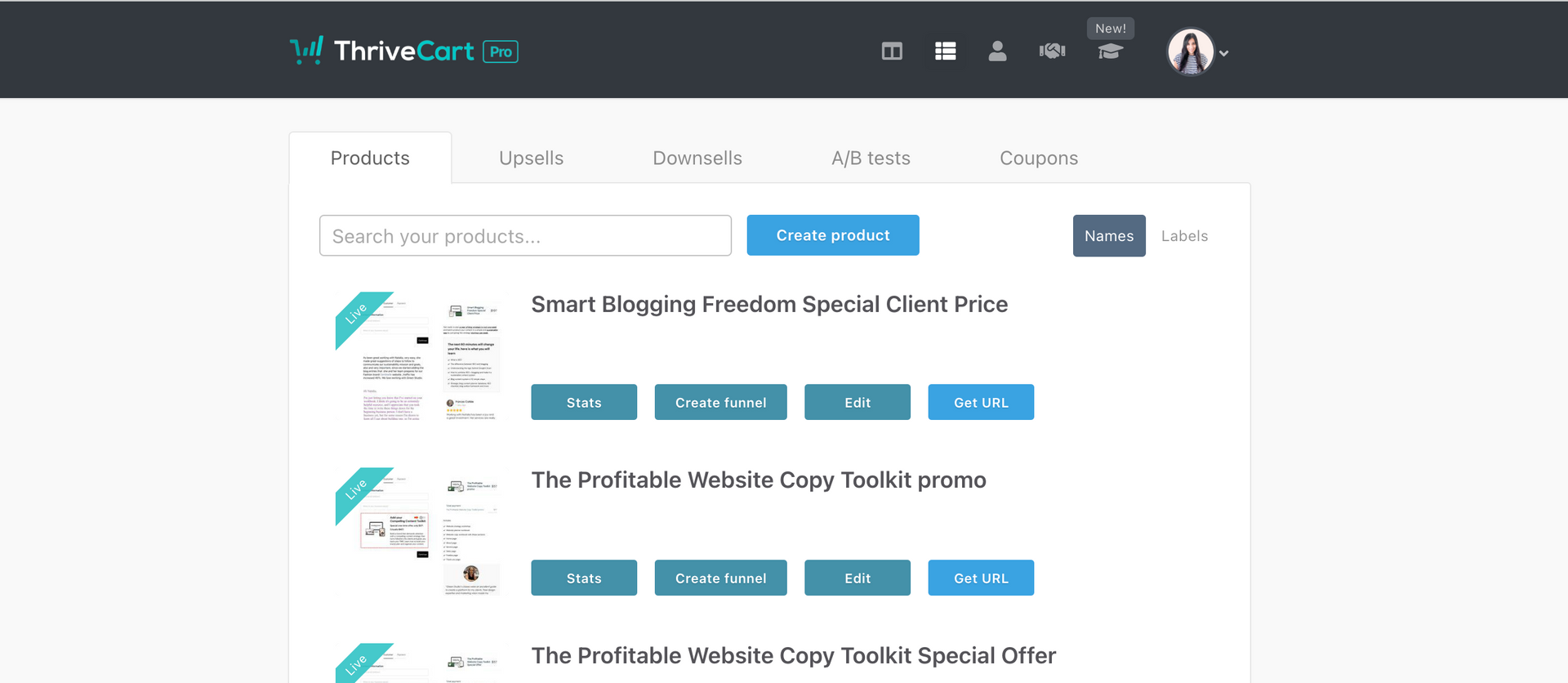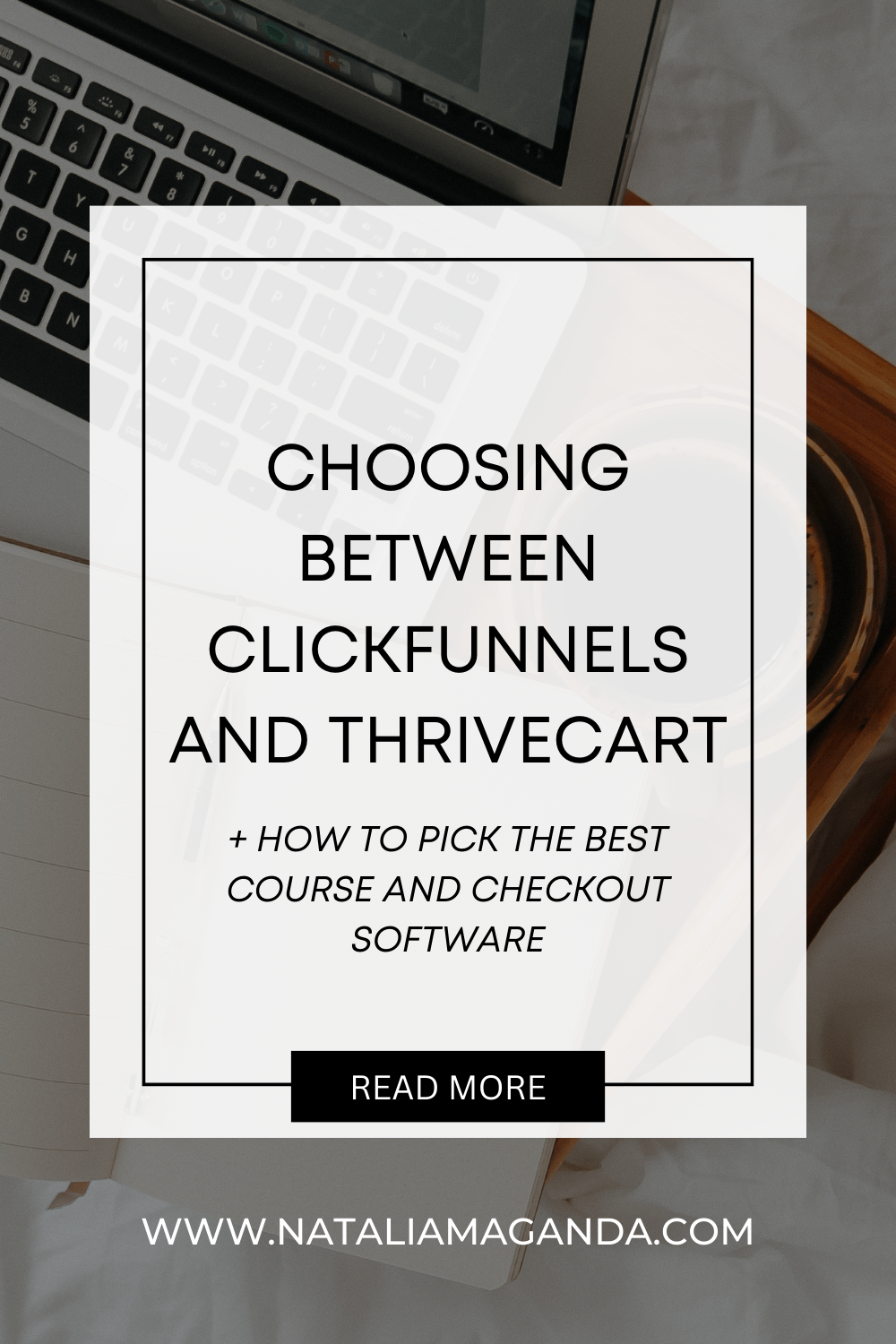ThriveCart vs ClickFunnels which is best for coaches
Selling online courses can be overwhelming. The abundance of options can leave you feeling stuck and unsure about which platform to choose. Should you go all-in with an all-in-one solution like ClickFunnels or save some bucks with ThriveCart? It's a tough decision, I get it. In this blog post, we'll explore the pros and cons of both platforms so that you can make an informed choice that aligns with your coaching or course creator business goals.
If we haven't met before, I'm Natalia Maganda and my mission is to help you stand out, gain visibility, and simplify your marketing efforts—one website at a time. Today, we're diving into the world of online course selling platforms and exploring the ultimate showdown between ThriveCart and ClickFunnels.
What exactly is ThriveCart?
ThriveCart
(affiliate link) is a powerful platform that offers a range of features designed to help you with your sales funnel. With ThriveCart, you can create stunning sales pages, upsell and downsell offers, and even manage affiliate programs seamlessly.
Imagine this: You've poured your heart and soul into creating a transformational online course. ThriveCart swoops in to streamline your sales process, making it easier than ever for dream clients to discover and purchase your offering. Plus, it integrates smoothly with popular email marketing tools like ConvertKit, Mailchimp, Mailerlite and more—automating your customer journey with countless options of data to export and connect via Zapier.

What exactly is ClickFunnels?
This all-in-one platform has gained a reputation for its simplicity and effectiveness in creating high-converting sales funnels. With ClickFunnels, you can build captivating landing pages, host webinars, and even manage your email marketing campaigns—all under one roof.
It comes with robust analytics and split-testing capabilities, you'll have the power to track data from your funnels and maximize conversions.

Main Differences between ThriveCart and ClickFunnels
Now that we've introduced both platforms, let's dive into the nitty-gritty of their differences.
1. Customization Options:
ThriveCart takes customization to a whole new level, allowing you to tweak every aspect of your sales process—from checkout pages to upsells and downsells. On the other hand, ClickFunnels offers pre-built templates that are easy to customize but may not provide as much flexibility.
2. Integrations:
Both platforms shines when it comes to integrations—they seamlessly connects with various payment gateways, and email marketing tools.
3. Pricing:
Here's where things get interesting! ThriveCart offers a one-time purchase option—an attractive proposition if you're looking to save money in the long run. ClickFunnels operates on a subscription model with different pricing tiers based on your needs.
What to consider when choosing between ThriveCart and ClickFunnels
As you weigh the pros and cons of each platform, several factors should guide your decision-making process. Let's take a closer look at what you need to consider:
1. Your Website Front-End Strategy:
Are you looking for beautifully designed sales pages or a simplified, streamlined funnel approach?
2. Your Website Back-End Strategy:
Do you require advanced membership site capabilities or additional features like webinar hosting?
3. Monthly and Annual Costs:
How does your budget align with the pricing plans of ThriveCart and ClickFunnels? Consider both short-term and long-term expenses.
4. Your Level of Tech Savviness:
Are you comfortable with more complex setups, or do you prefer a user-friendly interface that requires minimal technical know-how?
5. The Level of Automations and Integrations You Want to Have
: Do you need extensive automation capabilities and seamless integration with third-party tools?
Comparing Features Chart: ThriveCart vs ClickFunnels
How much does ThriveCart cost?
ThriveCart
offers a one-time purchase option starting at $495 for their Standard plan and $690 for their Pro plan. These prices may seem steep upfront, but remember, it's a lifetime investment that can save you thousands of dollars in the long run.

How much does SamCart cost?
On the other hand, ClickFunnels operates on a subscription model, with plans ranging from $97 to $297 per month, depending on your needs.
Check he
re the
latest pricing.

Which is better: ThriveCart or ClickFunnels?
The truth is, there's no one-size-fits-all answer—it all depends on your unique goals and preferences. However, if I had to choose one, my heart leans towards
ThriveCart
.
Why? Well, as a one-time purchase, ThriveCart offers an incredible amount of customization, integrations, and automations. Plus, the money you save in monthly subscriptions can be reinvested into growing your coaching business.
Choosing the right platform for selling your online courses is crucial for your success
By understanding the pros and cons of ThriveCart and ClickFunnels, you can make an informed decision that aligns with your business goals and budget.
Remember, there's no one size fits all solution. Consider your website front-end and back-end strategies, monthly and annual costs, tech savviness level, and desired level of automations and integrations.
Related reads:

* AI Disclosure: This content may contain sections generated with AI with the purpose of providing you with condensed helpful and relevant content, however all personal opinions are 100% human made as well as the blog post structure, outline and key takeaways.
* Affiliate Disclosure: Some of the links on www.nataliamaganda.com may contain affiliate links meaning that I will get a commission for recommending products at no extra cost to you.

hello! i'm natalia
Latina, web design expert for mental health professionals.
I help ambitious life coaches, therapists and holistic leaders amplify their magic, gain visibility, and simplify their marketing efforts through strategic web design and content.











